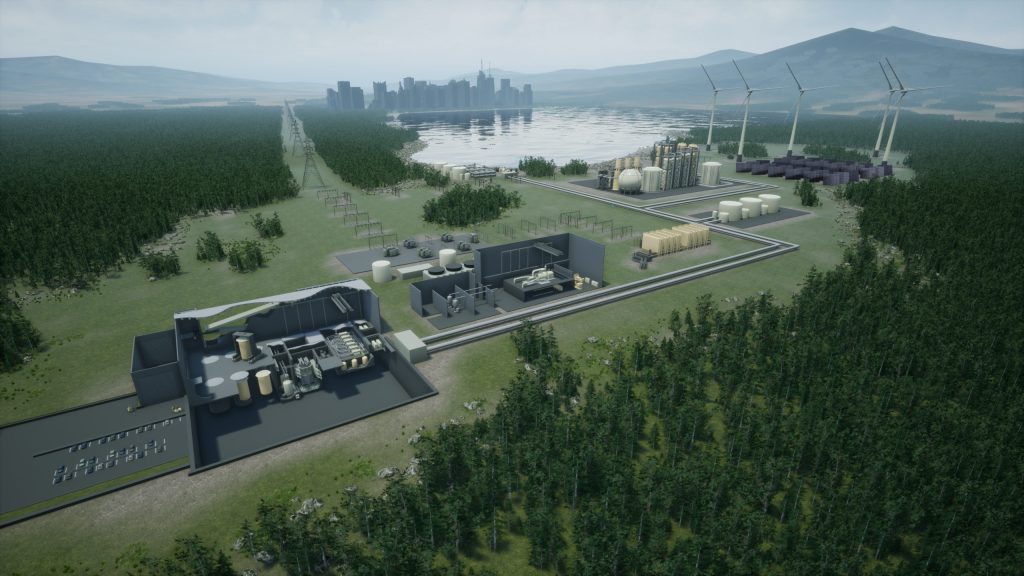What’s an MSR? A Molten Salt Reactor of Course!
Molten Salt Reactors are superior in many ways to conventional reactors.
In a Molten Salt Reactor, the uranium (probably Thorium in the future), is dissolved in a liquid fluoride salt. (Although fluorine gas is corrosive, fluoride salts are not.) Fluoride salts also don’t break down under high temperatures or high radiation, and they lock up radioactive material, which prevents it from being released to the environment.
As noted earlier, Dr. Alvin Weinberg’s Oak Ridge MSR ran successfully for 22,000 hours during the sixties. However, the program was shelved, partly for political reasons and partly because we [USA] favoured Admiral Rickover’s water-cooled reactors.

When uranium or thorium is combined with a liquid fluoride salt, there are no pellets, no zirconium tubes and no water, the source of the hydrogen that exploded at Chernobyl and Fukushima. The fluid that contains the uranium is also the heat-transfer agent, so no water is required for cooling. MSRs are also more efficient than LWR plants because the temperature of the molten salt is about 1300 F [700 C], whereas the temperature of the water in a conventional reactor is about 600 F [315 C], and higher heat creates more high-pressure steam to spin the turbines.
This extra heat can also be used to generate more electricity, desalinate seawater, split water for hydrogen fuel cells, make ammonia for fertilizer and even extract CO2 from the air and our oceans to make gasoline and diesel fuel. In addition, MSRs can be fueled with 96% of our stored uranium “waste” – spent fuel – and the fissile material in our thousands of nuclear bombs.
Why Hydrogen Needs Nuclear Power To Succeed by By Alan Mammoser – Mar 07, 2021
Hydrogen: The best shot for nuclear sustainability? by Susan Gallier, Nuclear News Dec 4, 2021
Because some MSR designs do not need to be water-cooled, those versions don’t risk a steam explosion that could propel radioactive isotopes into the environment. And because MSRs operate at atmospheric pressure, no huge, concrete containment dome is needed.
When the temperature of the liquid salt fuel rises as the chain reaction increases, the fuel expands, which decreases its density and slows the rate of fission, which prevents a “runaway” reaction. As a consequence, an MSR is inherently self-governing, and because the fuel is liquid, it can easily drain by gravity into a large containment reservoir. As a consequence, the results of a fuel “spill” from an MSR would be measured in square yards, not miles.
In the event of a power outage, a refrigerated salt plug at the bottom of the reactor automatically melts, allowing the fuel to drain into a tank, where it spreads out solidifies, stopping the reaction. In effect, MSRs are walk-away- safe.
Even if you abandon an MSR, the fuel will automatically drain and solidify without any assistance.
If the Fukushima reactor had been an MSR, there would have been no meltdown, and because radioactive by-products like caesium, iodine and strontium bind tightly to stable salts, they would not have been released into the environment. (In 2018 Jordan agreed to purchase two, 110 MW, South Korean molten salt reactors,)
May 2021 – Danish firm plans floating SMR for export South Korea firm to build floating nuclear plants. NuScale and Canadian firm to build floating MSRs. Saskatchewan Indigenous company to explore small MSRs.
August 2021 – Wall Street Journal – Small Reactors, Big Future for Nuclear Power
Progress
January 2022 – Modular Molten Salt Reactors Starting 2028
USEFUL MSR BYPRODUCTS
Besides producing CO2-free electricity, fissioning U-233 in an MSR creates essential industrial elements that include xenon, which is used in lasers, neodymium for super-strength magnets, rhodium, strontium, medical molybdenum-99, zirconium, ruthenium, palladium, iodine-131 for the treatment of thyroid cancers and bismuth-213, which is used for targeted cancer treatments.
Why are we so afraid of nuclear? By James Conca, 7 July 2015
Fuel needed for a 1,000 MW Power Plant per day
| 7 pounds Uranium 235 | No CO2 |
| 3.2 kg Uranium 235 | No CO2 |
| 9,000 tons Coal | 26,000 tons of CO2 |
| 240,000,000 cubic feet Natural gas | 320,000 cu ft of CO2 |
| 4,838 tons Natural gas | 16.6 tons of CO2 |
Coming up next week, Episode 19 – Want a Lift? Grab a LFTR
Links and References
1. Next Episode – Episode 19 – Want a Lift? Grab a LFTR
2. Previous Episode – Episode 17 – All At Sea – The Best Technology and Not Used. Why?
3. Launching the Unintended Consequences Series
4. Dr. George Erickson on LinkedIn
5. Dr. George Erickson’s Website, Tundracub.com
6. The full pdf version of Unintended Consequences
7. https://www.youtube.com/watch?v=nUg0QdtO6bQ
8. https://periodictable.com/Elements/090/pictures.html
9. https://www.youtube.com/watch?v=H6mhw-CNxaE
10. https://www.youtube.com/watch?v=N2vzotsvvkw
11. https://oilprice.com/Energy/Energy-General/Why-Hydrogen-Needs-Nuclear-Power-To-Succeed.html
12. https://www.linkedin.com/in/alan24/
13. https://www.ans.org/news/article-3472/hydrogen-the-best-shot-for-nuclear-sustainability/
14. https://www.linkedin.com/in/susan-bailey-gallier/
15. https://en.wikipedia.org/wiki/NuScale_Power
16. https://en.wikipedia.org/wiki/Terrestrial_Energy
17. https://www.wsj.com/articles/nuclear-power-generation-electricity-small-reactors-11629239179
18. https://www.nextbigfuture.com/2022/01/modular-molten-salt-reactors-starting-2028-in-canada.html
19. https://thehill.com/blogs/pundits-blog/energy-environment/247017-why-are-we-so-afraid-of-nuclear/
20. https://www.linkedin.com/in/jim-conca-2a51037/
21. https://www.aqua-calc.com/calculate/volume-to-weight
#UnintendedConsequences #GeorgeErickson #ClimateChange #FissionEnergy #NuclearEnergy #SpentNuclearFuel #MoltenSaltReactor #TheThoriumNetwork #Thorium #Fission4All #RadiationIsGood4U #GetYourRadiation2Day







You must be logged in to post a comment.